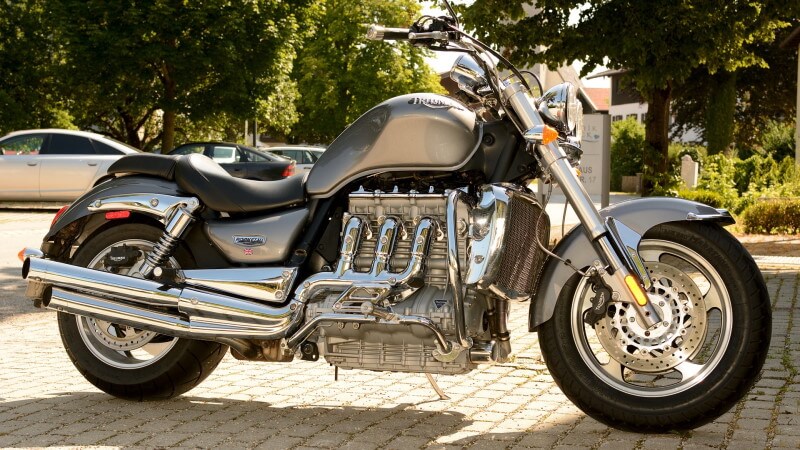
Safety and Motorcycle Size: Does Bigger Mean Safer?
A while ago, an ex-coworker of mine went and traded in his Mitsubishi Mirage for a brand new Chevy Silverado. He told me that he’d always been a “truck kind of guy” and that he felt a lot safer doing the school run with his kids in a bigger vehicle, because the Mirage felt too flimsy for his liking. I didn’t bring up the fact that the Silverado had one of the lowest safety ratings of all trucks, because he’d already bought it and I didn’t think he’d listen to me anyway.
The notion that a bigger vehicle is safer is actually quite common. As any automotive expert will tell you though, it’s also quite mistaken. Crash safety has little to do with a vehicle's size; there are large, unsafe cars, and small, safe cars, and vice versa. But this got me wondering: what about motorcycles? Are bigger motorcycles safer? Is there a correlation between size and crash safety in bikes?
Old studies from a few decades ago suggest that bigger bikes are more accident-prone, while more recent research indicates there may be no causal relationship between motorcycle size and safety. Yet other studies suggest that the severity of crashes is significantly higher for bigger bikes.
That’s probably not what you want to hear if you’re trying to determine what sort of motorcycle would be the safest for you to ride. But worry not. In this post, we’ll deconstruct the research together, and arrive at the most unbiased, rational conclusions possible.
Displacement vs Safety
First things first. In the context of motorcycles, what exactly does “bigger” mean? Is it the mass of the motorcycle? The wheelbase? The height or width? To be fair, any of these factors could affect how accident-prone a motorcycle is, and how it behaves in crashes.
But there isn’t much published research examining the effects of these dimensions on motorcycle safety. What does exist though, is research that looks at engine size (i.e., displacement) versus accident risk. (And anyway, bikes with high engine displacements are typically also physically bigger and heavier than bikes with lower displacements.)
Some studies from the 70s and 80s find a positive relationship between the accident involvement of motorcycles and their engine displacement. In contrast, more recent studies find no relationship between engine size and increased accident risk, and a 2004 study even found that, “bikes over 125cc had accident liabilities that were 15% lower than riders of smaller bikes”. (Note: This same study also observes that although bikes below 125cc had a higher accident rate, the severity of those accidents was lower compared to more powerful bikes.)
The older research doesn’t really make much sense, and here’s why. One of the biggest factors that determines the severity of a crash is the overall energy involved. The faster a vehicle is going and the more mass it carries, the higher the energy in the event of a crash. How fast a motorcycle can go depends on its power-to-weight ratio -- the more horsepower it has for every pound (or kilogram) that it weighs, the faster it can go. And a motorcycle’s engine size is NOT a good indicator of its performance or its power-to-weight ratio, at all.
For instance, let's take the example of the Triumph Rocket 3 GT (which features the biggest engine of any production motorcycle), the Harley Davidson CVO Street Glide, the Suzuki GSX-R750, and the Kawasaki Ninja ZX-6R 636. Take a look at the table below to see how these four motorcycles compare in terms of performance versus displacement.
Two things are clear from the table above. Firstly, even though the ZX-6R 636 has the lowest engine displacement at 74 percent smaller than the Rocket GT 3, the former still outperforms the latter, with a power-to-weight ratio that is 42 percent higher than the Rocket GT 3. And secondly, there is no correlation between displacement and performance.
As any sportbike enthusiast will tell you (over and over again, without you even asking), a typical 600 cc (37 cu in) supersport motorcycle will accelerate faster than other types of motorcycles with much bigger engines, and reach much higher top speeds.
Even smaller motorcycles with nearly identical engine displacements can have considerable variation in performance. The Yamaha SR400, Suzuki DR-Z400S and KTM RC 390 R, are all motorcycles with engine capacities between 370 and 399 cc (22 - 24 cu in). Again, the RC 390, with the smallest engine, has the highest power output at 43 HP, while the Yamaha and Suzuki make 23 and 32 HP respectively.
Given that there is no correlation between engine displacement and how a motorcycle behaves -- how quickly it accelerates, how fast it can go, how efficiently it can stop, how easily it can turn, and so on -- there’s little reason to expect that its safety performance will correlate with displacement either.
Power-to-Weight Ratio vs Safety
Differences in performance are often greater when comparing models across different motorcycle types (sport, touring, cruiser, standard, etc). This is because each type is designed with a different set of objectives in mind. But what if we compare the safety performance of motorcycles according to motorcycle type?
This is the question that the authors of this study have examined, and the differences are immediately evident. For instance, between the years 2000 and 2008, supersport motorcycles had the highest driver death rate of all motorcycles compared in the study. In fact, supersports performed 336 percent worse than cruiser/standard motorcycles.
Which brings us to an important point: power-to-weight ratio. Supersports bikes have the highest power-to-weight ratio of any type of motorcycle, and they also happen to have the highest number of deaths per 10,000 registered supersport bikes. Cruisers, on the other hand, generally have the lowest power-to-weight ratios owing to their high weight and relatively low power output. Cruisers have one of the lowest death rates per 10K registered cruisers.
This does NOT imply a causal link between power-to-weight ratio and accident rate, because there are many other factors (like rider age, experience, attitude, use-case, etc) that are also associated with a bike’s safety record. But it’s safe to say that bikes that accelerate quicker and reach higher top speeds, demand quicker reflexes and better skills to control them, compared to sluggish and slow bikes.
Certainly, an identical amount of throttle input from a rider will produce dramatically different results on a bike with a high power-to-weight ratio, versus another with a low ratio. It follows, therefore, that on high power-to-weight ratio machines, the margin for error is smaller, and the risk of losing control, possibly greater,
This is why licensing authorities across Europe and Australia have taken to restricting newer riders to motorcycles with low power-to-weight ratios.
Conclusion: What Bike Should You Ride?
To summarize, the latest research available shows no correlation between safety and motorcycle size (engine displacement). Bigger motorcycles aren’t necessarily safer than smaller motorcycles, but neither are they necessarily more risky.
Power-to-weight ratio seems to be a stronger and more consistent correlation with accident risk. Motorcycles with a high power-to-weight ratio tend to correlate with higher accident and fatality rates.
So, if you’re looking to prioritize safety, what motorcycle should you ride?
Well, “work your way up” is always good advice. Regardless of how long you’ve been riding motorcycles, it always makes sense to gradually move up from relatively low-powered machines to bikes with more power.
The EU standard of about 0.1 kilowatt per kilogram (0.28 HP / lb) makes sense if you’re new to riding. If you’ve already got a few hundred hours (or a few thousand miles) of riding experience under your belt, you could consider more powerful bikes.
But remember: riding a bike with a low power-to-weight ratio is NOT a guarantee of safety. After all, serious injury or death can even occur in a very low-speed crash on a low-power bike. There’s no substitute for common sense, caution, and improving your skills as a rider.
I hope this post shed some light on size versus safety in motorcycles and that you found it useful. What's your take on the size vs safety question? Agree, disagree, or undecided? Let me know in the comments -- I normally respond to every single comment. Have fun, and ride safe!
